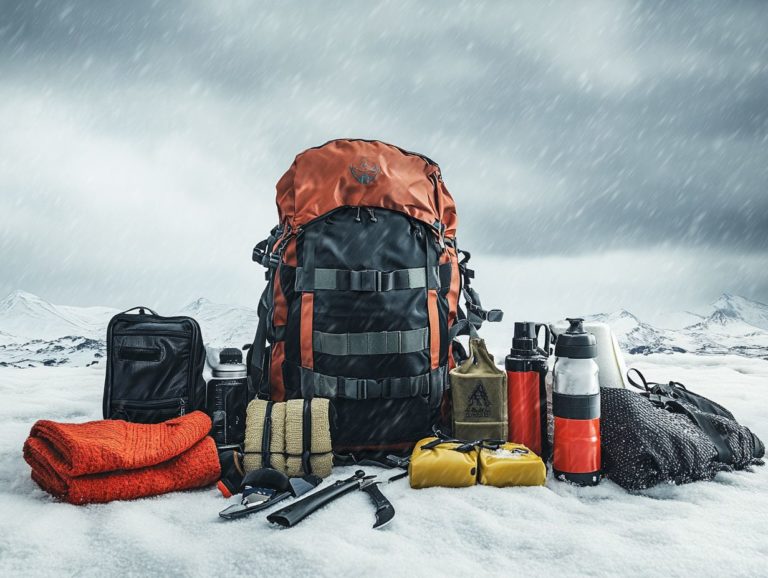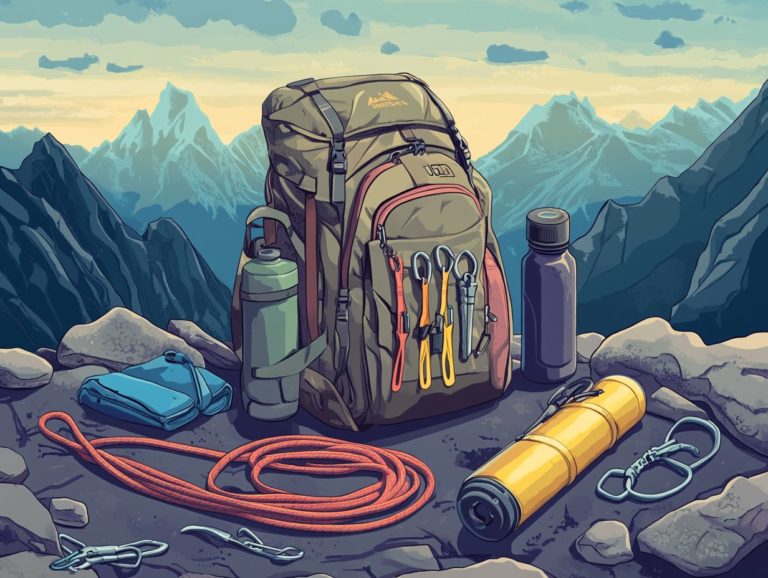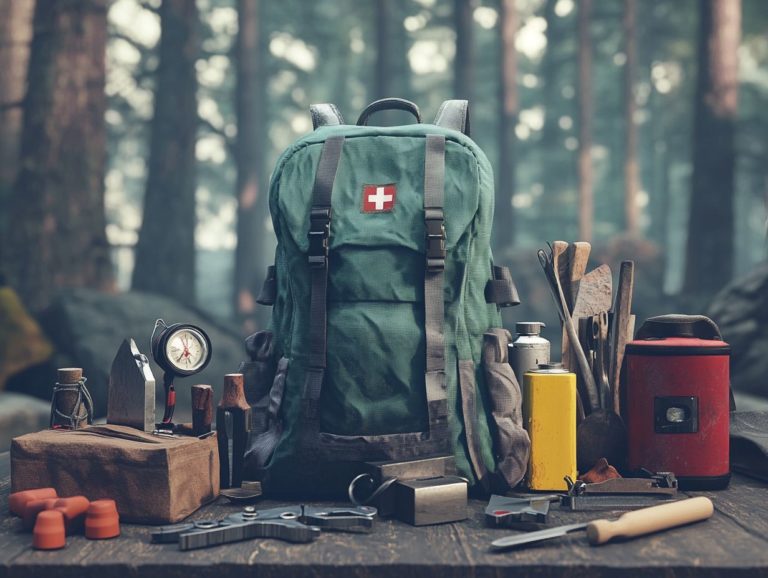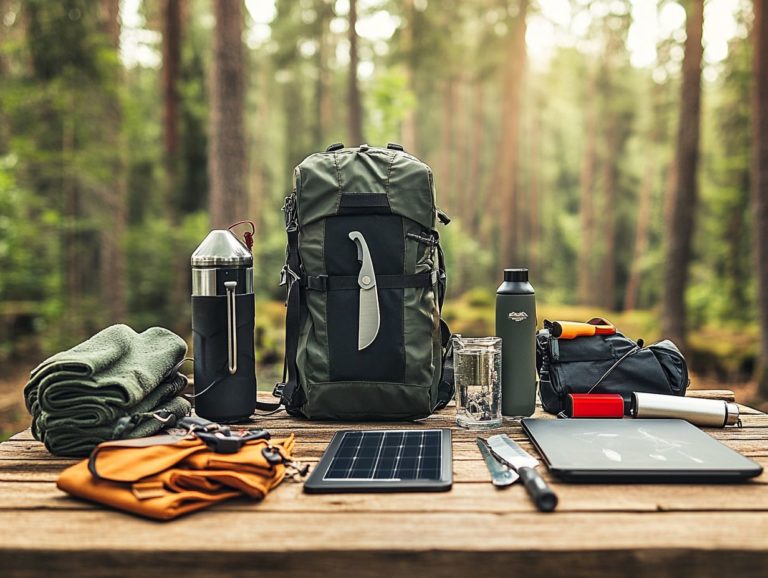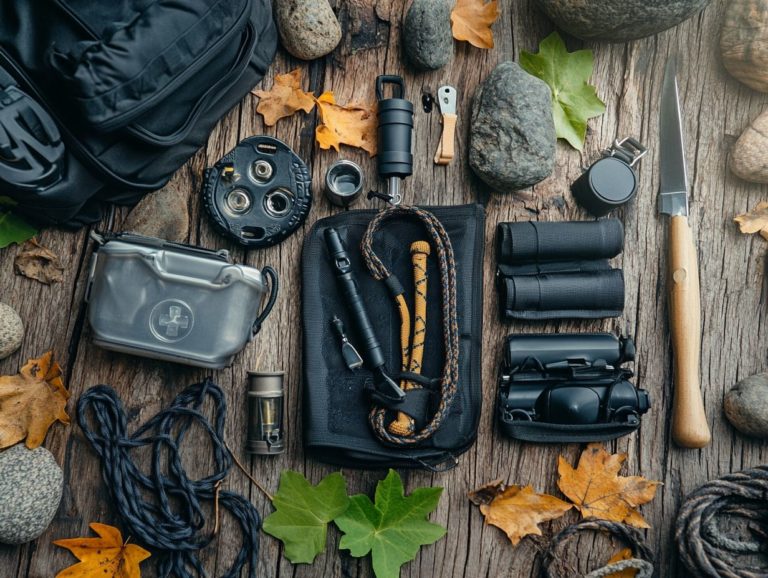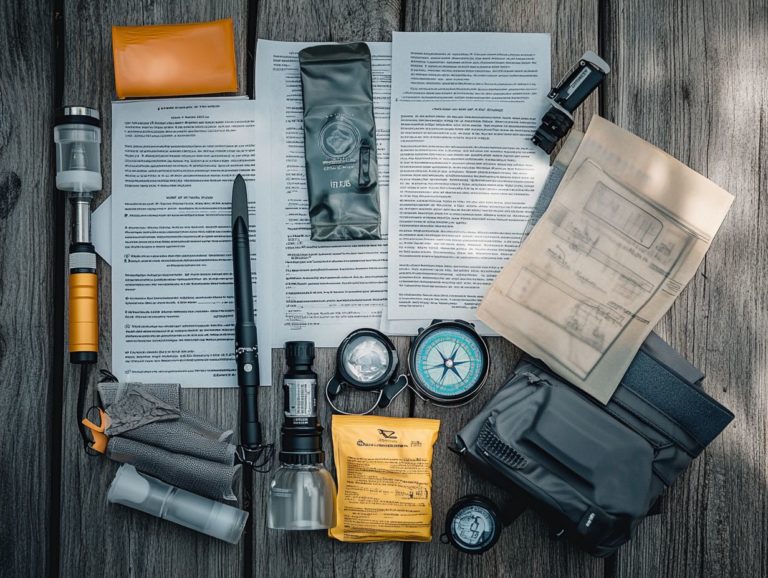How to Pack Your Survival Gear Efficiently
Packing survival gear efficiently, including items like a comprehensive survival kit, is essential for anyone gearing up for emergencies or outdoor adventures. By adopting the right approach, you can maximize space, accessibility, and organization, ensuring that everything you need is readily at hand.
This guide delves into the essentials, from must-have gear to ingenious packing tips for clothing, food, and tools. Get ready to transform how you pack for survival adventures!
Contents
- Key Takeaways:
- Importance of Efficient Packing for Survival Gear
- Essential Items for Survival
- Organizing and Categorizing Your Gear
- Choosing the Right Backpack
- Packing Techniques for Different Types of Gear
- Keeping Your Gear Safe and Secure
- Additional Tips for Efficient Packing
- Frequently Asked Questions
- What is the most important factor to consider when packing your survival gear?
- How can I organize my survival gear effectively?
- What are some essential items to include in my survival gear pack?
- How should I pack my survival gear to save space?
- Is it necessary to pack multiple forms of shelter in my survival gear?
- How often should I review and update my survival gear?
Key Takeaways:
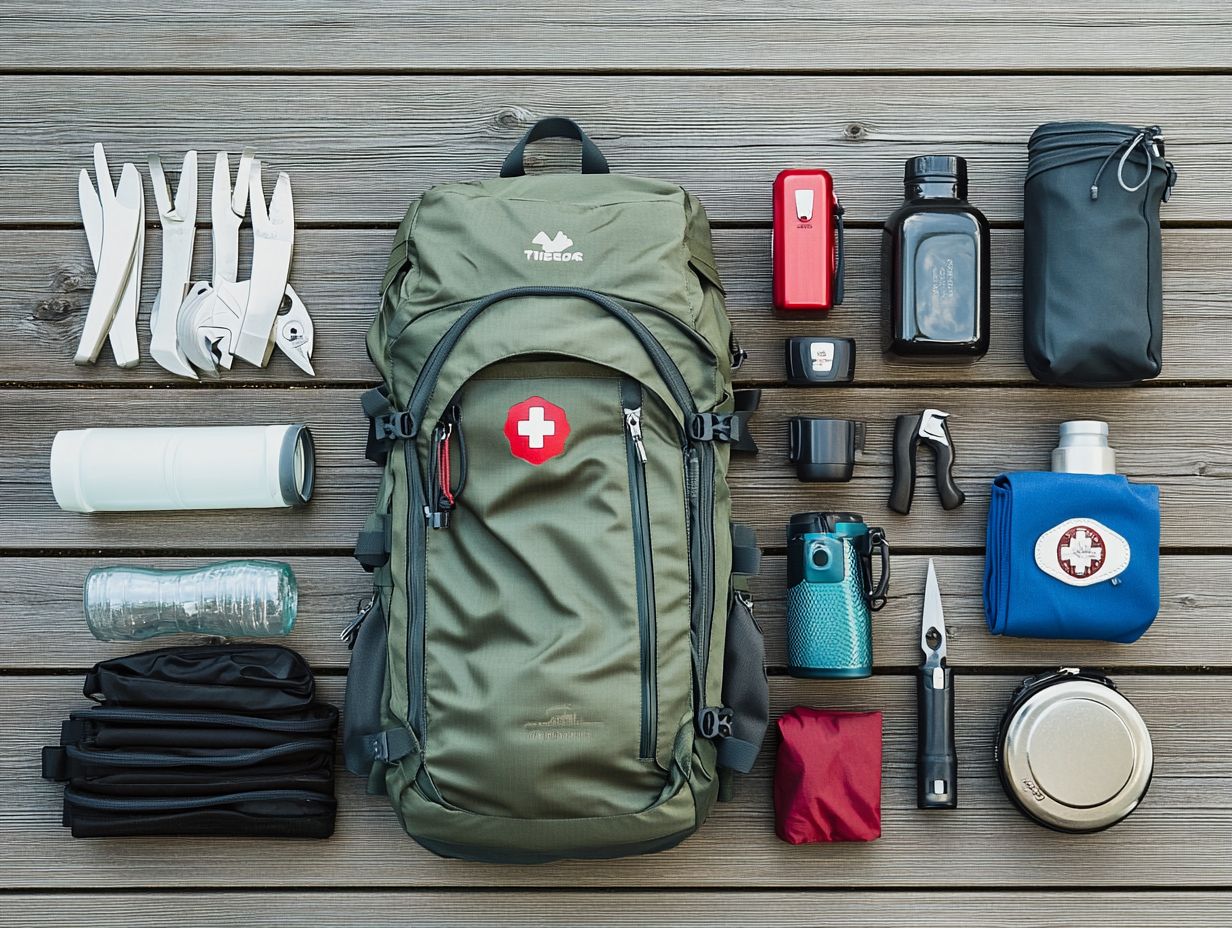
- Pack only essential survival gear to save space and weight.
- Organize and categorize your gear for quick and easy access.
- Choose the right backpack and use efficient packing techniques to maximize space and prevent damage or loss of gear.
Importance of Efficient Packing for Survival Gear
Efficient packing of your survival gear is essential when venturing into the wilderness or getting ready for emergencies. It ensures that all your vital items, from a comprehensive survival kit to a reliable evacuation backpack, are both accessible and well-organized.
In moments of crisis, a carefully packed emergency bag can truly be the difference between life and death. This underscores the importance of weight distribution, which means placing heavier items closer to your back for better balance, and organization. By using effective packing strategies, you can optimize space and accessibility, ensuring your outdoor gear is not only manageable but also ready for immediate use. For more insights on this, check out how to use survival gear in emergency situations.
Maximizing Space and Accessibility
Maximizing space and accessibility in your survival gear is crucial for quickly locating and utilizing your emergency supplies when you need them most. Implementing various techniques can significantly enhance your organizational efficiency during emergencies.
For instance, using packing cubes allows for compartmentalization, keeping your supplies grouped by function. This way, you can easily retrieve water, food, or first aid items without having to rummage through your entire pack. Additionally, knowing how to prepare survival gear for emergencies can further enhance your readiness.
It’s also vital to consider weight distribution; placing heavier items close to the back helps maintain balance, making movement easier. When you combine these methods, not only do you keep your gear organized, but you also ensure swift access to essential outdoor equipment during high-stress situations, preparing you for whatever challenges may come your way.
Essential Items for Survival
In any emergency situation, certain essential items become crucial for your survival. A comprehensive survival kit is essential, including a well-stocked first-aid kit, a reliable multi-tool like the Swiss Army knife, and effective water purification methods, such as Aquatabs or iodine tablets.
A durable survival knife is also vital for a variety of tasks, while medical supplies, including a CAT tourniquet, ensure you’re ready for any injuries that may arise. By knowing these crucial gear items, you can craft a bug-out bag tailored to your unique needs, whether you’re a novice survivalist or a seasoned outdoor enthusiast.
Must-Have Gear for Any Emergency Situation
When you re preparing for emergencies, it s crucial to include essential gear like emergency blankets, fire-starting tools, and a tactical backpack for effective storage of your supplies.
These items are vital when surprises happen, helping you maintain warmth, hydration, and safety in tough conditions. Take emergency blankets, for example they re compact and lightweight, making them easy to carry. Yet their ability to retain body heat can be lifesaving in freezing temperatures.
Fire-starting tools are equally invaluable; they can provide warmth, purify water, and cook food when traditional methods aren’t an option. A tactical backpack is your best friend for organized storage, ensuring that all your necessary gear is easily accessible during a crisis, significantly enhancing your survival odds. Additionally, knowing how to store survival gear for longevity can further improve your readiness for any situation.
Organizing and Categorizing Your Gear
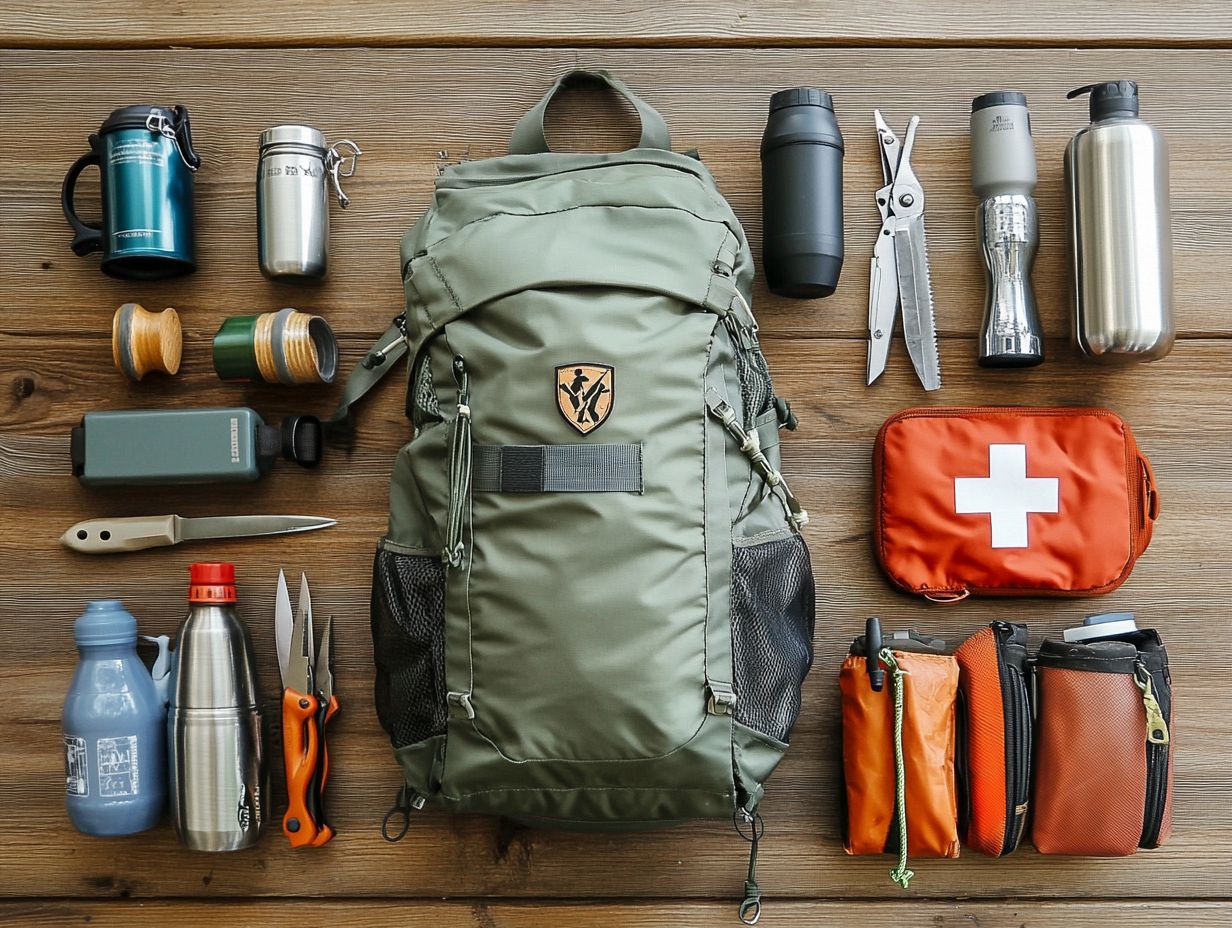
Organizing and categorizing your gear is essential for efficient access and utilization, especially in high-pressure situations where survival instincts kick in and every second counts. A well-organized survival toolkit turns the frantic search for critical outdoor gear like medical supplies or multi-tools into a streamlined process. This organization helps you respond swiftly to emergencies, enhancing your survival skills.
By using effective packing strategies, you can ensure that each item is stored logically, granting you seamless access when it matters most.
Creating a System for Easy Access
Establishing a streamlined system for easy access to your survival gear is crucial. Incorporating packing cubes within a sturdy backpack can significantly improve your organization.
Group your items into designated cubes one for first-aid supplies, another for cooking tools, and a third for clothing. This simplifies your packing process. For instance, by placing a compact first-aid kit, necessary medication, and emergency blankets in their own cube, you ensure quick access when urgency strikes. At the same time, keeping essentials like a portable stove, cooking utensils, and lightweight meals together allows you to prepare food efficiently without rummaging. Additionally, consider what to include in your survival gear kit to ensure you have everything you need for any situation.
This systematic approach not only optimizes weight distribution, making your backpack more comfortable to carry, but also facilitates quicker retrieval during emergencies, significantly enhancing your overall preparedness.
Choosing the Right Backpack
Selecting the right backpack is essential for any survival scenario, as it determines how efficiently you can transport your bug-out bag and vital outdoor gear. A well-chosen backpack ensures that everything stays secure and easily accessible during emergencies.
Factors to Consider When Selecting a Backpack
When choosing a backpack, carefully consider factors like weight distribution, capacity for essential items, and the design of an evacuation backpack. These elements are crucial for ensuring your comfort and efficiency in emergencies.
Make sure your backpack fits all your gear without weighing you down. The material is important too; opting for high-quality fabrics often means greater durability and weather resistance, keeping your belongings safe in various conditions. An adjustable harness can make a world of difference in weight distribution, helping you maintain balance and reduce fatigue. Additionally, pockets and compartments enhance organization, allowing quick access to important items.
By paying attention to these details, you can make a reliable choice that meets your specific needs in unexpected situations.
Packing Techniques for Different Types of Gear
Utilizing effective packing techniques for various types of gear is essential. It enables efficient storage of clothing, food, and tools, while optimizing space and organization within your survival kit.
Tips for Packing Clothing, Food, and Tools
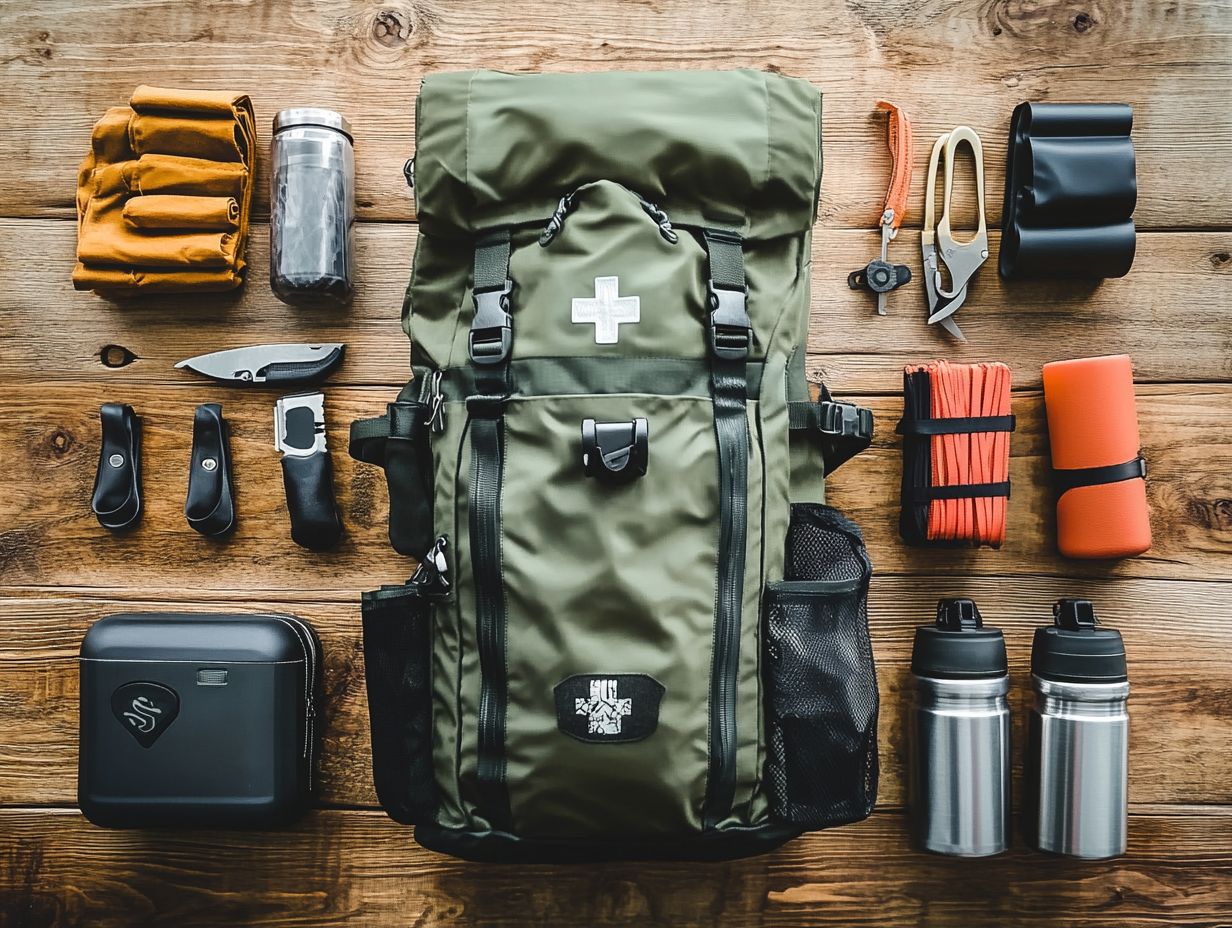
When preparing to pack clothing, food, and tools for survival situations, employing specific strategies can enhance your readiness and ensure easy access to all your outdoor gear.
First, prioritize layering your clothing to adapt to changing weather conditions. Use moisture-wicking materials which draw sweat away from your body and insulation while avoiding cotton. Next, focus on non-perishable food items that are both lightweight and nutrient-dense, such as:
- Energy bars
- Dried fruits
- Nuts
These options provide essential sustenance like lightweight gear without taking up much space in your pack. For tools, choose compact multi-tools and basic first aid supplies that equip you for immediate challenges and serve well in long-term survival scenarios. Additionally, learning how to train with your survival gear can further enhance your preparedness.
By employing organized packing techniques such as grouping similar items together and using clear, labeled bags, you’ll guarantee quick access during emergencies. Additionally, understanding how to use hiking gear for survival can further enhance your preparedness. This kind of thoughtful preparation allows you to face uncertainties with poise and confidence.
Keeping Your Gear Safe and Secure
Ensuring the safety and security of your gear is crucial, particularly in unpredictable environments. By taking proactive measures, you can effectively protect your survival supplies and outdoor equipment, preserving your readiness for any adventure.
Preventing Damage and Loss
To safeguard your essential gear, it’s crucial to use waterproof paper for important documents and store items like a survival knife and multi-tool securely.
You should also consider the right storage solutions, such as hard cases or padded pouches. These options shield your sensitive equipment from impact and moisture. Look for storage with features like dividers and foam inserts to keep items organized and accessible.
Handle your gear carefully to avoid damage. Stay away from extreme temperatures or unstable environments that could harm your equipment. By implementing these protective measures, you can significantly extend the lifespan of your gear and ensure it’s ready for any situation.
Additional Tips for Efficient Packing
Incorporating tips for efficient packing can elevate your ability to maximize space and optimize weight distribution in your tactical backpack. This ensures you have every essential item while maintaining comfort throughout your journey.
Maximizing Space and Weight Distribution
Maximizing space and weight distribution in your bug-out bag is essential for carrying all necessary emergency supplies without feeling overwhelmed.
Using effective organization techniques can boost your packing efficiency. One popular method is packing cubes, which create compartments for clothing, gear, and tools, maximizing available space.
Opt for lightweight gear, like ultralight tents and compact cooking equipment, to reduce your bag’s overall weight. A well-structured layout conserves space and facilitates quick access to critical supplies during emergencies.
For instance, placing essential items like first-aid kits and flashlights in the topmost cube ensures they’re readily available when you need them most.
Frequently Asked Questions
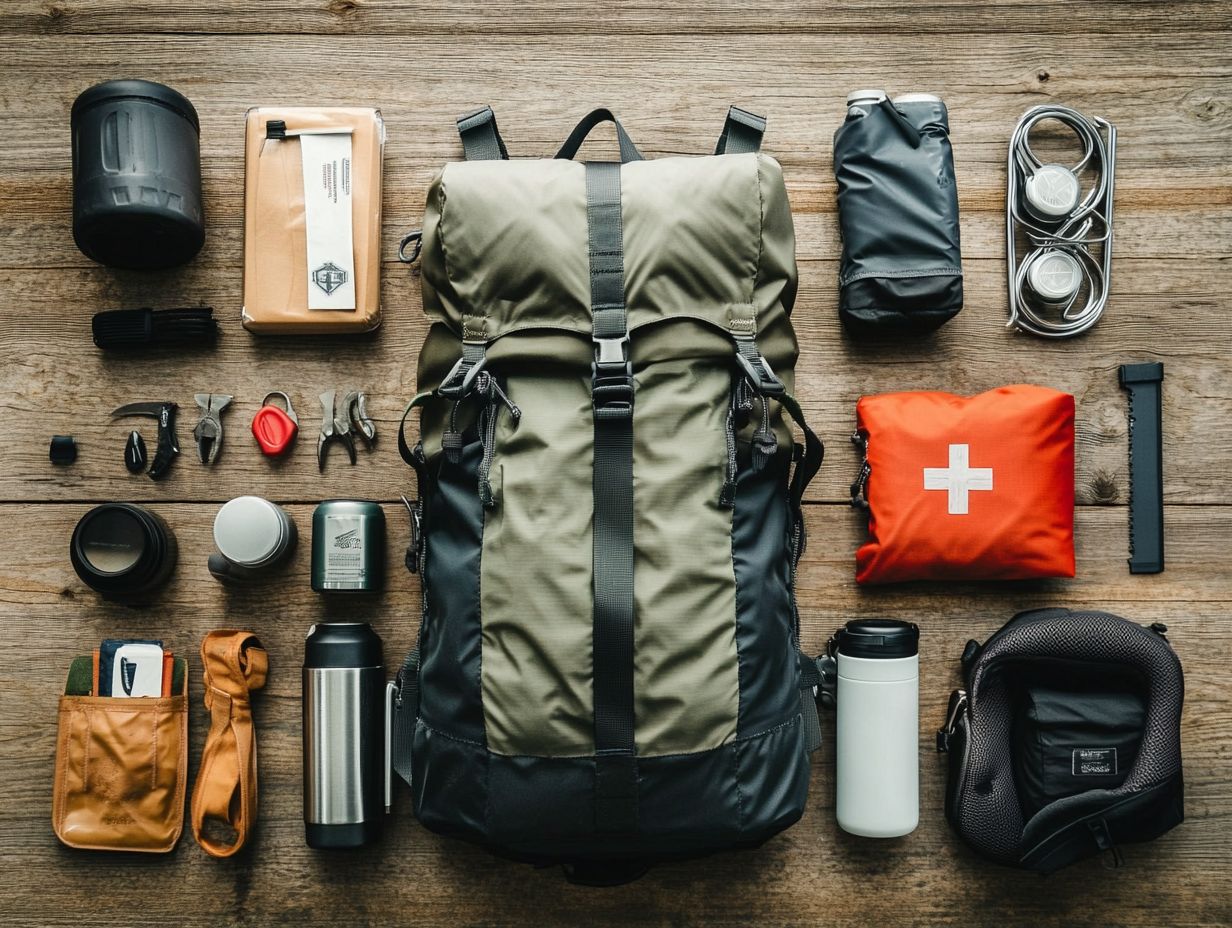
Here are some frequently asked questions to help you with your survival gear packing:
What is the most important factor to consider when packing your survival gear?
The most important factor is weight. Ensure your gear is light enough to carry while including all essentials for survival.
How can I organize my survival gear effectively?
Organize your gear by using a checklist to ensure you have all necessary items. You can also use different colored bags or containers to group similar items for easy access.
What are some essential items to include in my survival gear pack?
Essential items include a first-aid kit, a map and compass, water purification tablets, a multi-tool, and a fire starter. It’s also crucial to pack enough food and water for at least three days.
How should I pack my survival gear to save space?
Rolling clothing and using compression bags can save space in your pack. Remove bulky packaging and repack items into smaller containers.
Is it necessary to pack multiple forms of shelter in my survival gear?
Yes, having multiple forms of shelter is important in case one gets damaged or lost. This could include a tent, tarp, or emergency bivvy.
How often should I review and update my survival gear?
Review and update your survival gear at least twice a year, or more frequently if you use it often. This ensures your gear is in good condition and that you have all necessary items for your specific location and needs.
Don’t wait until it’s too late check your gear today!

